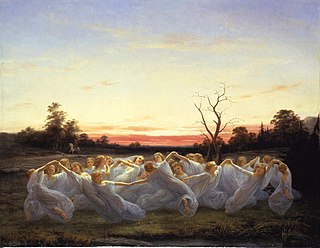
An elf is a type of humanoid supernatural being in Germanic folklore. Elves appear especially in North Germanic mythology, being mentioned in the Icelandic Poetic Edda and Snorri Sturluson's Prose Edda.

A dwarf is a type of supernatural being in Germanic folklore. Accounts of dwarfs vary significantly throughout history; however, they are commonly, but not exclusively, presented as living in mountains or stones and being skilled craftspeople. In early literary sources, only males are explicitly referred to as dwarfs. However, they are described as having sisters and daughters, while male and female dwarfs feature in later saga literature and folklore. Dwarfs are sometimes described as short; however, scholars have noted that this is neither explicit nor relevant to their roles in the earliest sources.
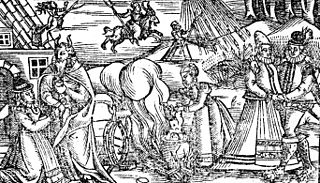
Isobel Gowdie was a Scottish woman who confessed to witchcraft at Auldearn near Nairn during 1662. Scant information is available about her age or life and, although she was probably executed in line with the usual practice, it is uncertain whether this was the case or if she was allowed to return to the obscurity of her former life as a cottar’s wife. Her detailed testimony, apparently achieved without the use of violent torture, provides one of the most comprehensive insights into European witchcraft folklore at the end of the era of witch-hunts.
Fairies, particularly those of Irish, English, Scottish and Welsh folklore, have been classified in a variety of ways. Classifications – which most often come from scholarly analysis, and may not always accurately reflect local traditions – typically focus on behavior or physical characteristics.
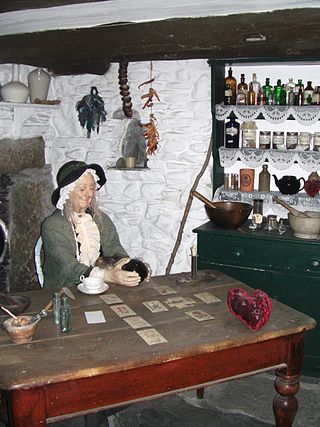
The cunning folk were professional or semi-professional practitioners of magic in Europe from the medieval period through the early 20th century. In Britain they were known by a variety of names in different regions of the country, including wise men and wise women, pellars, wizards, dyn hysbys, and sometimes white witches.

A mare is a malicious entity in Germanic and Slavic folklore that walks on people's chests while they sleep, bringing on nightmares.

The Lacnunga ('Remedies') is a collection of miscellaneous Anglo-Saxon medical texts and prayers, written mainly in Old English and Latin. The title Lacnunga, an Old English word meaning 'remedies', is not in the manuscript: it was given to the collection by its first editor, Oswald Cockayne, in the nineteenth century. It is found, following other medical texts, in London, British Library Harley MS 585, a codex probably compiled in England in the late tenth or early eleventh century. Many of its herbal remedies are also found, in variant form, in Bald's Leechbook, another Anglo-Saxon medical compendium.
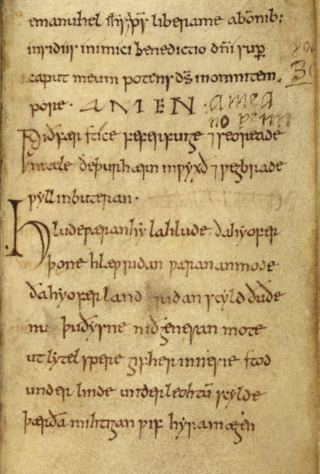
"Wið fǣrstice" is an Old English medical text surviving in the collection known now as Lacnunga in the British Library. Wið fǣrstiċe means 'against a sudden/violent stabbing pain'; and according to Felix Grendon, whose collection of Anglo-Saxon charms appeared in the Journal of American Folklore in 1908, “the charm is intended to cure a sudden twinge or stitch, possibly rheumatism that can be due to being shot by witches, elves, and other spirits that fly through the air.” Scholars have often sought to identify this as rheumatism, but other possibilities should not be excluded. The remedy describes how to make a salve, but its main interest lies in the unique charm which follows. This describes how the færstice has been caused by the projectiles of 'mighty women', whom the healer will combat. The charm also mentions elves, believed responsible for elfshot, and provides the only attestation outside personal names of the Old English form of the name of the old Germanic gods, known as the Æsir in Norse mythology.
A thunderstone is a prehistoric hand axe, stone tool, or fossil which was used as an amulet to protect a person or a building. The name derives from the ancient belief that the object was found at a place where lightning had struck.
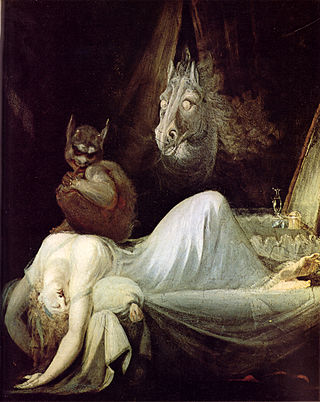
An Alp is a supernatural being in German folklore.

Iron has a long and varied tradition in the mythology and folklore of the world.
In the historical folklore of Sicily, Doñas de fuera were supernatural female beings comparable to the fairies of English folklore. In the 16th to mid-17th centuries, the doñas de fuera also played a role in the witch trials in Sicily.
Anglo-Saxon metrical charms were sets of instructions generally written to magically resolve a situation or disease. Usually, these charms involve some sort of physical action, including making a medical potion, repeating a certain set of words, or writing a specific set of words on an object. These Anglo-Saxon charms tell a great deal about medieval medical theory and practice. Although most medical texts found from the pre-Christian Anglo-Saxon period are translations of Classical texts in Latin, these charms were originally written in Old English.
In J. R. R. Tolkien's writings, Elves are the first fictional race to appear in Middle-earth. Unlike Men and Dwarves, Elves are immortal, though they can be killed in battle. If so, their souls go to the Halls of Mandos in Aman. After a long life in Middle-earth, Elves yearn for the Earthly Paradise of Valinor, and can sail there from the Grey Havens. They feature in The Hobbit and The Lord of the Rings. Their history is described in detail in The Silmarillion.
Queen of Elphame or "Elf-hame", in the folklore belief of Lowland Scotland and Northern England, designates the elfin queen of Faerie, mentioned in Scottish witch trials. In ballads and contemporary texts, she is referred to as Queen of Elphane, Elphen, or the Fairies. She is equivalent to the Queen of Fairy who rules Faërie or Fairyland. The character as described in witch trials has many parallels with the legends of Thomas the Rhymer and Tam Lin.

Cunning folk, also known as folk healers or wise folk, were practitioners of folk medicine, helpful folk magic and divination in Europe from the Middle Ages until the 20th century. Their practices were known as the cunning craft. Their services also included thwarting witchcraft. Although some cunning folk were denounced as witches themselves, they made up a minority of those accused, and the common people generally made a distinction between the two. The name 'cunning folk' originally referred to folk-healers and magic-workers in Britain, but the name is now applied as an umbrella term for similar people in other parts of Europe.
Magic in Anglo-Saxon England refers to the belief and practice of magic by the Anglo-Saxons between the fifth and eleventh centuries AD in Early Mediaeval England. In this period, magical practices were used for a variety of reasons, but from the available evidence it appears that they were predominantly used for healing ailments and creating amulets, although it is apparent that at times they were also used to curse.

Three Anglo-Saxon metrical charms "Against a dwarf" are contained within the Lacnunga, which seek to heal an afflicted person by ridding them of a dwarf.
Witchcraft in Anglo-Saxon England refers to the belief and practice of magic by the Anglo-Saxons between the 5th and 11th centuries AD in Early Mediaeval England. Surviving evidence regarding Anglo-Saxon witchcraft beliefs comes primarily from the latter part of this period, after England had been Christianised. This Christian era evidence includes penitentials, pastoral letters, homilies and hagiographies, in all of which Christian preachers denounce the practice of witchcraft as un-Christian, as well as both secular and ecclesiastical law codes, which mark it out as a criminal offence.
"For Water-Elf Disease" is an Anglo-Saxon metrical charm that was intended for use in curing the "water-elf disease," which was a disease supposedly caused by elf-shot from water elves. It is written in Old English and derives from Bald's Leechbook.










